If you have a fern in your garden, you are the steward of a pre-Jurassic period plant!
Fossil records indicate that ferns evolved as the first vascular terrestrial plants over 300 million years ago.
Ferns have outlived dinosaurs, the great civilizations of man, and flourish in the wild in great numbers with no threat of extinction.

I'm so impressed with these plants that the more I learn about ferns, the more I love them.
There are thousands of fern species today and a number of them are suitable as house plants.
Unfortunately, many people have issues keeping these robust plants alive.
I'm here to guide you.
My latest gardening segment on the Home & Family show was on "Ferns 101," where I covered basic fern care and showcased a few new varieties.
Below is an informal transcript of questions and answers from my garden segment and lots and lots of photos for you to enjoy.
HOW ARE FERNS DIFFERENT FROM MOST PLANTS?
Ordinary plants will flower and bear seed from which a new plant is born.
A seed is basically a "fertilized plant embryo in a dormant state."
A seed is the product of male/female plant reproduction, with all the "hanky panky" already completed.
Just add water and watch it grow!
Not so for ferns.
Ferns do not grow from seeds; they "evolve" from the action of spores.
The fern's lifecycle involves two generations of plants that give rise to the fern plant as we know it.

Have you ever seen little black or brown dots on the backside of a fern frond and thought it was a pest or disease?
Far from it.
These little dots are called "sori" and they contain hundreds of spores.
A simple way to describe spores is that they are a couple of steps behind on the reproductive work of the seed and have to play "catch up."
A fern drops a spore in the ground, giving rise to an independent tiny plant called a gametophyte.
The gametophyte is charged with the job of actually creating the very male and female parts within itself needed to procreate and produce yet another life: the sporophyte!
Stay with me.
If the male part within the gametophyte's cells fertilizes the female part, it gives birth to a plant organism called a sporophyte.
We're finally there!
The sporophyte then grows into the lovely fern plants that we are familiar with.
Wow, that takes me back to high school biology!
If you want to read more about the lifecycle of the fern with all the scientific terms and processes I left out on purpose, here's a link.
Another cool fact about ferns that distinguishes it from other plants is the function of the fronds.
The fronds, or leaves, are responsible for both photosynthesis AND reproduction.
WHAT FERNS DID YOU BRING TODAY?
I brought some common ferns that many people at home may be familiar with.
Notice the different frond styles, textures and colors.
There are infinite differences in ferns. Some ferns creep and grow like vines, others grow small or large tufts, while others grow trunks and are tree-like!
Let's take a look.
COMMON FERNS

Australian tree fern is a slow growing fern that can reach 20 feet tall and 10 feet wide.
As a house plant, it would take many years for it to grow this large.

Another handsome tree fern is the New Zealand tree fern, seen here to the right of the Wardian chest.
The dark, large forrest green leaves create a beautiful shadow on walls.

Sword fern has erect fronds that look nice in the rectangular profile of this window box.

The Pallaea "button fern" has delicate, round, button-shaped leaves that should be enjoyed up close.
The terrarium planter helps seal in moisture so that it doesn't dry out.

Button fern in foreground and hanging Boston fern in background.

I placed the leather leaf fern and lace fern close to each other by design.
Grouping ferns helps them to maintain a higher moisture level.
Notice that I also placed the pots on top of a bed of gravel.
The gravel holds water that contributes humidity to the ferns.
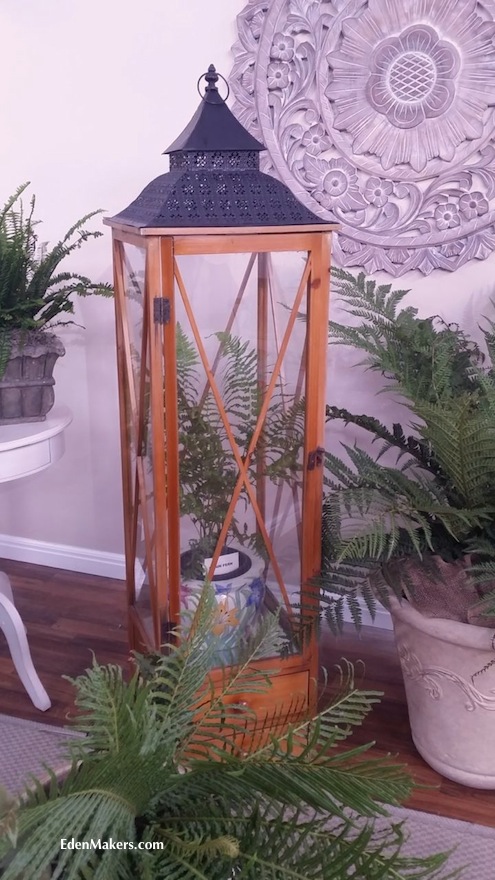
A young lace fern (Woodwardia f.) stays moist and happy in the Victorian-style Wardian chest.

The Blechnum fern bears fertile leaves, with spores, and sterile leaves without spores.
These are called "dimorphic" fronds.
WHAT NEW FERN VARIETIES DID YOU BRING?
Fern collectors are always looking for new cultivars with interesting details.
Here are some from Plant Delights, a specialty plant mail order company.
Many of these new introductions come from Japan, China, India and Hawaii.
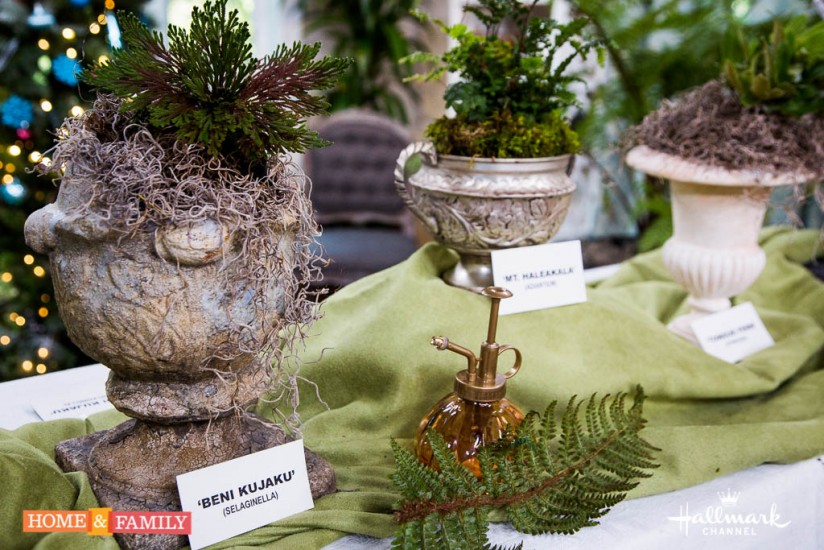
I planted the ferns in an assortment of different containers that had an aged look.
The closest one to the left is a broken finial from my garden.

This graceful fern is called “Mama Mia” (Woodwardia o.) and is slow growing to 4 to 6 feet.
As it continues to grow, the glossy fronds are topped with small plants that you can propagate!
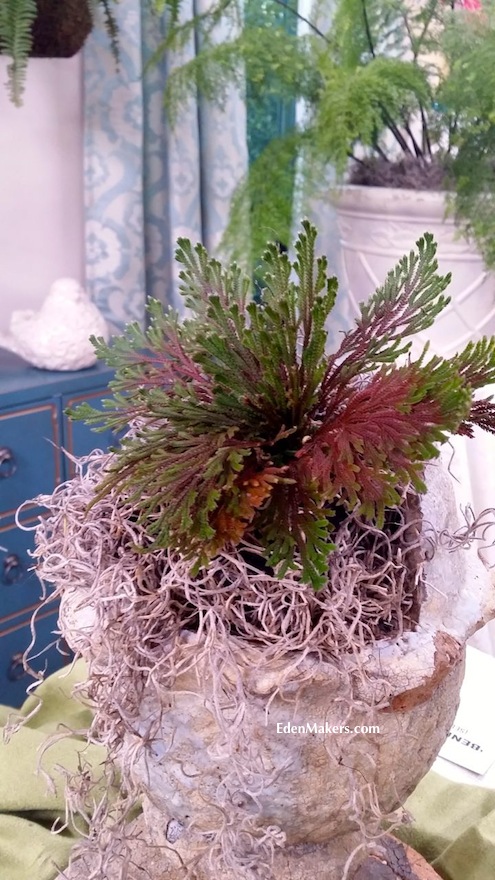
This bi-colored gem is actually not a fern.
'Beni Kujaku' is a Selaginella that is sometimes called peacock fern because of its lacy, cut leaves.
Beni Kujaku has a rosette form with a cup-like shape and is a deep green and maroon color.
This plant will stay small and look great in a container!

'Mt. Haleakala' (Adiantium) is a rosy maidenhair fern that will grow into an attractive 1-foot tall x 1-foot wide clump with fronds that emerge rosy red.
The spores on 'Mt. Haleakala' grow along the edge of the leaves, creating a curled effect.
As you may guess, this Adiantium is from Hawaii.

'Hokaido Gem' (Asplenium) is a clumping birds nest fern with long, tongue-like strappy leaves.
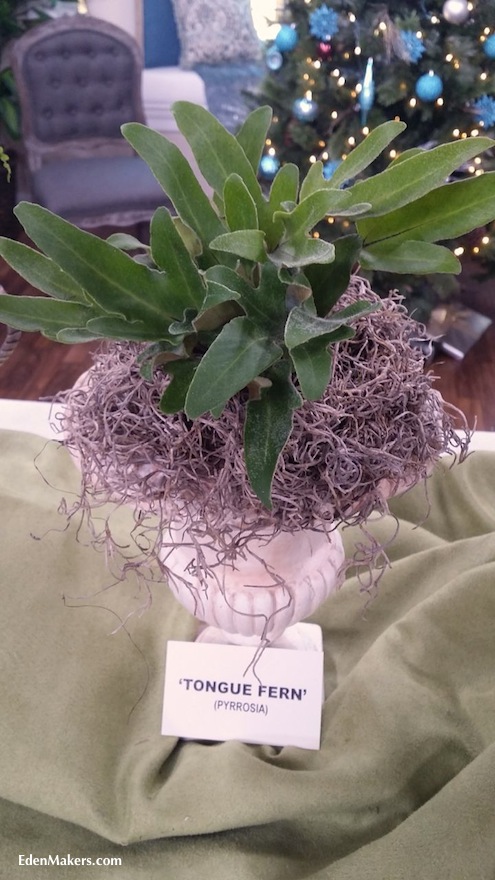
'Taiwanese Tongue' fern (Pyrrosia polydactyla) will grow to 1-foot tall x 1-foot wide and boast a textural clump of velvety five-fingered dark green leaves.
HOW DO YOU CARE FOR INDOOR POTTED FERNS?
Lighting and watering habits are two of the most important care practices that impact indoor ferns.
While ferns are shade plants outdoors, often growing under the canopy of taller trees, ferns do need bright light indoors!
During the summer, a south-facing window may let in harsh sunlight that will scorch your fern leaves.
It's best to set the plants away from the window, but to keep them in a room that has natural light.
Pay attention to:
–Proper location – bright but indirect light, 60-75 degrees
–Use well-draining potting soil for ferns
–Water to keep soil moist but not saturated and mist leaves periodically
–Add room humidifier or group plants to slow evaporation.
–Fertilize with slow release granules in spring.
HOW MUCH WATER DO FERNS NEED?
The main challenge with keeping ferns moist is that indoor air tends to be very dry and ferns prefer a humid ambiance.
Between keeping the soil moist and periodic misting, you will eventually learn how much water is best for your fern.
Too much water feels like dripping wet hair, when it actually should feel moist, like hair that is air drying!
Look for signs of too much water, like yellow leaves, wilting leaves, soil that has a bad smell and cut back.
Water and proper soil texture go hand in hand.
Soil should drain well so that water doesn't saturate it.

Shirley explains how to water ferns on Home & Family while Cristina Ferrare, Mark Steines listen.

I found this adorable little mister at the dollar store.
Watch my garden segment video about ferns on the Home & Family Show.
Thank you for visting EdenMakers blog.
I invite you to subscribe to my blog so you can receive notices of new blog posts, videos and TV appearances.

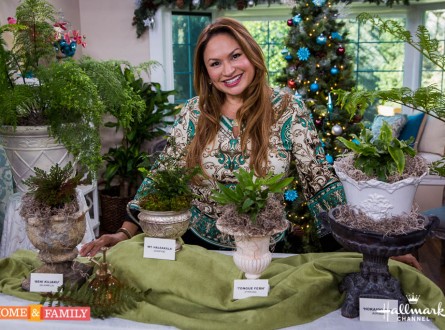
Hi Mary,
Thank you for visiting EdenMakers blog and for your comment.
Unfortunately, because Home & Family is a national show, I can only present on general subjects that MOST of the audience can relate to. This is why I spoke about “indoor ferns” since everyone can use the same information.
Thank you for your request! Please continue watching the show.
Shirley
Thanks for getting people excited about ferns. Could you do another for hardy Northern Fern, not inside or southern types.
Thank you for visiting EdenMakers. I will take a look at your ferns.
Hello Shirley and Andrew,
Shirley we love your Fern Blog
Please have a look at vitroplus.nl for more fern news!
Andrew, Yes we like ferns in Green Walls, what about this living painting in my own office with Maidenhair and Blue Star and believe me, Maidenhair normally is very difficult to maintain because you loose it when you forget watering but not in this wall since they stay nice and humid all the time!
regards,
John Bijl
lovely Shirley…great I LOVE ALL FERNS..kamaljeetsingh
Hi Andrew,
Thanks for visiting EdenMakers. I haven’t planted ferns in a living wall planter since they require so much water and humidity.
Perhaps in a northern, (shady) exposure, or indoors they would do well.
Hi Shirley…love to hear about what you have to say about using ferns on living green walls.Experience, comments etc.